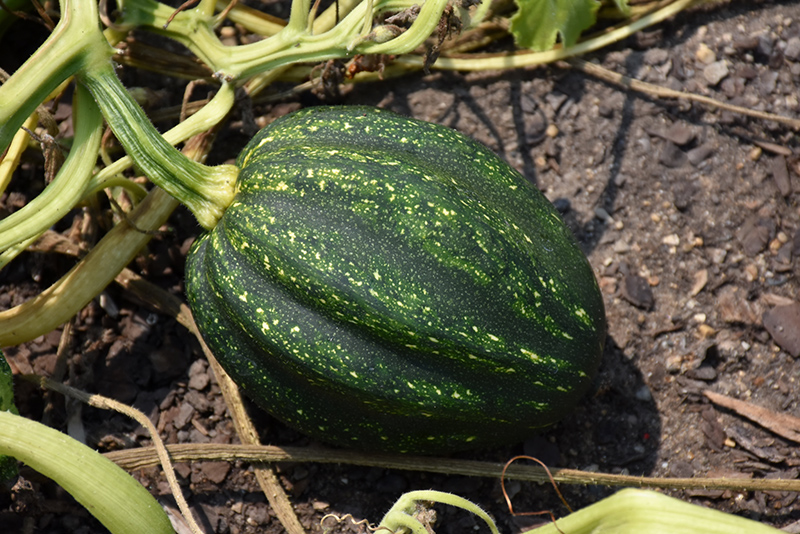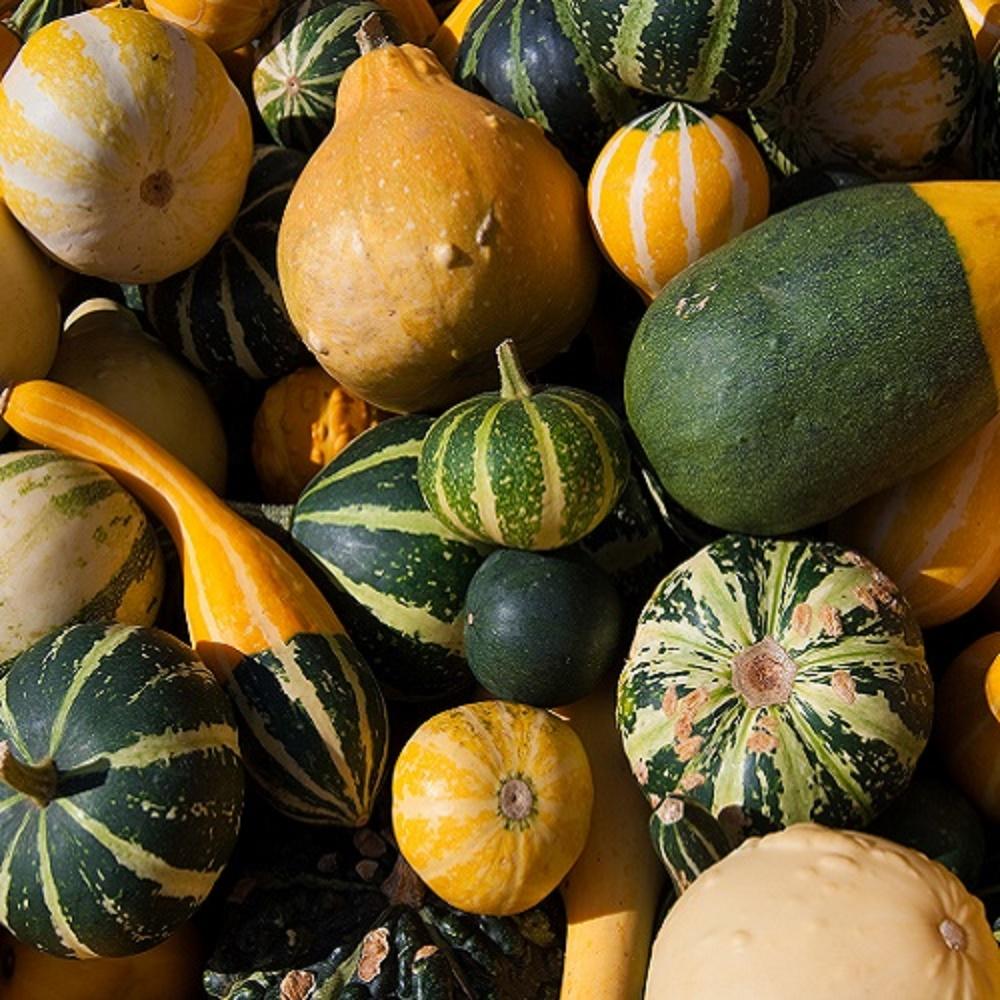
Acorn squash (Cucurbita pepo var. turbinata) Flickr Photo Sharing!
Cucurbita pepo, commonly referred to as acorn squash, is a sprawling vine with yellow fruit-bearing flowers. The fruits have a mild flavor and can be fried, baked, added to pasta, used in soups, and more. Native to North America, acorn squash is an aggressive grower and prefers moderately moist soil with full access to sunlight.

Acorn Squash (Cucurbita pepo var. turbinata) in Denver Arvada Wheat Ridge Golden Lakewood
Pumpkin is a winter squash in the Cucurbitaceae plant family, alongside melons, spaghetti squash, and cucumbers. The most popular varieties of squash belong to one of three species: Cucurbita pepo , C. moschata, and C. maxima. Although often considered a vegetable, Pumpkin is botanically classified as a fruit, as it grows from a flowering plant.

Vegetable Cucurbita pepo Squash Small fruited Mix 45 seeds eBay
Along this spectrum of botanical malleability lies the spaghetti squash, a selection of the common pumpkin ( Cucurbita pepo var. pepo) which is itself a catch-all assemblage of hybrids. Like all cucurbits, spaghetti squash is a large, fast-growing annual with stout stems and large, three-lobed leaves. Unlike pumpkin vines which we think as.

Squash 'Sure Thing' Cucurbita pepo Garden Living
Pattypan squash, also known as scallop squash, is a lesser-known cultivar of the summer squash (Cucurbita pepo), the species that also includes zucchini and crook-neck squash. If you think you'd like to add some pattypan plants to your garden, you can start by checking out the following varieties:

SQUASH HYBRID 49ER F1 Cucurbita pepo Squash Summer from Seeds by Design
Phonetic Spelling koo-KER-bih-ta Description. Cucurbita is a genus of annual, warm-season, vining plants in the cucumber family (Cucurbitaceae) native to North and South America.It includes commonly cultivated vegetables (although botanical terms, they are fruit) such as summer and winter squashes, pumpkins, zucchini, and ornamental gourds.

SQUASH OP EARLY PROLIFIC STRAIGHTNECK Cucurbita pepo Squash Summer from Seeds by Design
Summer squash (Cucurbita pepo) is a warm-season crop that has a tender rind and doesn't store for more than a few days. It has a bushy semi-vining form and takes about 45 to 55 days to mature.

Cucurbita pepo (Squash) Plantinfo
Cucurbita Pepo (C. pepo) The pumpkin varieties most people recognize are from the Cucurbita Pepo group. These are the bright orange-skinned pumpkins carved as jack-o-lanterns or decorated for the Thanksgiving season. Members of Cucurbita Pepo include some of the most common squash seen in the grocery store, such as acorn, spaghetti, yellow.

PlantFiles Pictures Summer Squash 'Multipik' (Cucurbita pepo), 1 by Farmerdill
Zucchini, Summer Squash 'Aristocrat' (Cucurbita pepo) Care Guide. Select a sunny site, away from trees and close to a water source if possible. Prepare the garden by breaking up the existing soil (use a hoe, spade, or power tiller) to a depth of 12-16" (30-40cm). Add organic matter such as manure, peat moss or garden compost until the.

Heap of US American Delicata Squash, Peanut Squash, Cucurbita Pepo Stock Photo Image of
Plant description. Cucurbita pepo has a high number of varieties, so can vary in appearance. Generally, they are trailing vines that can grow across the ground or as climbers on a support. Leaves have between three to five lobes, are various shades of green, can have white veining and short sharp hairs. Fruits are widely varied, including large.

Cucurbita pepo (Squash) Plantinfo
Facts. Pumpkin (Cucurbita pepo) includes both pumpkin and several summer squash cultivars. This plant sometimes escapes from vegetable gardens and dump areas. The seeds have medicinal value as a natural antihelminthic (treatment for intestinal worms).

SQUASH OP EARLY SUMMER CROOKNECK Cucurbita pepo Squash Summer from Seeds by Design
Squash, a diverse and delicious vegetable, comes in various shapes, sizes, and flavors. Among the numerous squash varieties, three species stand out: Cucurbita moschata, Cucurbita pepo, and Cucurbita maxima. Understanding the distinctions between these species can help you make informed choices when selecting, cooking, or growing squash. In this blog post, we will delve into the unique.

Botany Cucurbitaceae Squash (Cucurbita pepo Stock Photo Alamy
Acorn squash (Cucurbita pepo var. turbinata), also called pepper squash or Des Moines squash, is a winter squash with distinctive longitudinal ridges on its exterior and sweet, yellow-orange flesh inside. Although considered a winter squash, acorn squash belongs to the same species (Cucurbita pepo) as all summer squashes (including zucchini and crookneck squash).

Pumpkin, squash, gourd and other Cucurbita species Feedipedia
Planting. Summer squash (Cucurbita pepo) is a warm-season crop that grows best at average temperatures between 65 and 75 °F. Squash seeds do not germinate well in cold soil. In the spring, do not plant this crop until after the last chance of frost has passed, and the soil temperature is 60 ºF, 4-inches below the surface.

Cucurbita pepo (Squash) Plantinfo
Cucurbita pepo is a cultivated plant of the genus Cucurbita.It yields varieties of winter squash and pumpkin, but the most widespread varieties belong to the subspecies Cucurbita pepo subsp. pepo, called summer squash.. It has been domesticated in the Americas for thousands of years. Some authors maintain that C. pepo is derived from C. texana, while others suggest that C. texana is merely.

Yellow Squash (Cucurbita pepo) My Garden Life
Also called: zucchini, ( Cucurbita pepo ), variety of summer squash in the gourd family ( Cucurbitaceae ), grown for its edible fruits. Zucchinis are common in home gardens and supermarkets, and the young fruits are cooked as a vegetable. The flowers are also edible and are sometimes fried. Zucchini plants are typically bushy and non-vining.

Crookneck Squash (Cucurbita pepo) Stock Image F031/3146 Science Photo Library
Squash (Cucurbita pepo ssp. ovifera var. ovifera) was an early domesticated crop in Eastern North America. Unlike the squash we are used to today, this squash was more gourd than squash, having a hard shell, and an egg-like shape. Shells of these squash have been found that date to 5000 B.C. Domestication of these plants can be seen archeologically through an increase in seed size.